AccessScope Project
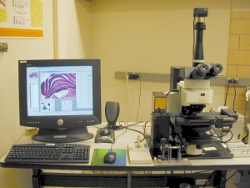
Microscope Components
- Computer User Interface
-
The user interface for controlling AccessScope is a software application to control all hardware components of the microscopy workstation. The PC running Microsoft® Windows® serves as an ideal user interface for persons with disabilities because it can easily be adapted to accommodate different disabilities and personal preferences. PCs can be controlled by a variety of input devices including the keyboard, mouse, digitizer tablet, or trackball. Likewise, different commercial assistive technology and accessibility software applications can be used to control the PC.
-
- Automated Research Microscope
-
The major hardware component of the AccessScope workstation is an Olympus® BX61® research microscope. This microscope is a fully motorized upright light microscope with automated six-objective nosepiece, focus, condensor, lamp, diaphragms, and filter wheel. The microscope can receive commands from a PC and send back status signals through a RS232C 'serial' connection.
-
- Bulk Slide Autoloader
-
Persons without hand function cannot load slides onto the microscope stage by themselves. Therefore, unless something can be used to accomplish this task then students cannot be independent. We attached a bulk slide autoloader by Ludl® to the motorized stage. Controlled through the computer the autoloader loads slides by using a lever to grab specific slides from the mobile cassettes and place it onto the stage. When unloading a slide, the lever pushes the slide off of the stage into its place in the cassette from where it came. The slide autoloader has two cassettes each holding twenty-five slides. If each slide contains ten specimens, then the autoloader could feasibly provide user access to five hundred histological specimens without needing assistance to reload more slides.
-
- Motorized Stage
-
A motorized microscope stage by Ludl® Electronics Products Ltd. The motorized stage can move a slide in X, Y, and Z directions. Stage movement is controlled through a joystick. The stage can also be automated for advanced functions like aligning multiple fields of view and automated scanning.
-
- Digital Camera
-
An Olympus® CC12 digital video camera mounted atop the microscope displays a real-time view of the slide in a preview window of the user interface. The 'live' display replaces the need to use the microscope eyepieces. Test subjects with mobility or visual impairments found viewing slides from the computer monitor to be much easier than peering through the microscope eyepieces. The ergonomics of wheelchair and scooter seating do not lend itself to conventional microscope viewing.
-
AccessScope - Past, Present & Future
The foundation for developing an accessible microscopy workstation like AccessScope is based on the critical role this piece of equipment plays in the training, success and longevity of a career scientist. There is a vast amount of information regarding the nature/composition of organism, structures, etc. contained within cells which require the aid of a microscope for visualization and thus investigation.
The aims for developing AccessScope were driven by the principle that dexterity does not equal mental prowess. In essence, just because one may have mobility impairments does not mean their brain is not as logic driven, creative, and astute as is necessary for a successful career in science related fields.
At IAS, our goal is to positively impact the success of both scientists in training and in practice on a national scale. As a result, the future of AccessScope is to enable remote control usage through a users’ PC interface.
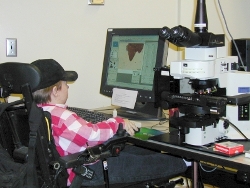 AccessScope Aims
AccessScope Aims
Many laboratory procedures are inaccessible to students and scientists with hand and arm mobility impairments. One of the most basic laboratory skills a student learns is microscopy. We developed a prototype automated light microscope that can be independently operated from a computer workstation by students with upper limb mobility impairments. We evaluated how persons with upper limb impairments, including those caused by polio, spinal cord and brainstem injury, rheumatoid arthritis, and meningitis, interacted with the microscope workstation and again in their ability to perform common microscopical functions.
A student with juvenile rheumatoid arthritis operates the automated microscope workstation. The accessible microscopy workstation is controlled from a personal computer that both operates the microscope and displays slides on the monitor in lieu of the eyepiece, which is inaccessible from a wheelchair. The PC serves as an ideal interface for operating the workstation, because it is adaptable to each individual's ability by using different peripheral pointing devices and accessibility software. The workstation table is also motorized to adjust to the user's height.
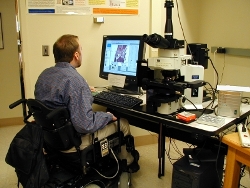 The microscopy workstation is controlled by a quadriplegic subject with a spinal cord injury. A bulk slide autoloader and motorized XYZ stage holds up to fifty slides. Once someone loads slides into the slide autoloader, the user with a disability can change slides from a graphical window and control all microscopical functions from the computer without any assistance. With this system a user with upper limb impairments can also perform graduate level research tasks, such as image capturing, morphometry and image analysis, fluorescence imaging, and 3D serial section reconstruction.
The microscopy workstation is controlled by a quadriplegic subject with a spinal cord injury. A bulk slide autoloader and motorized XYZ stage holds up to fifty slides. Once someone loads slides into the slide autoloader, the user with a disability can change slides from a graphical window and control all microscopical functions from the computer without any assistance. With this system a user with upper limb impairments can also perform graduate level research tasks, such as image capturing, morphometry and image analysis, fluorescence imaging, and 3D serial section reconstruction.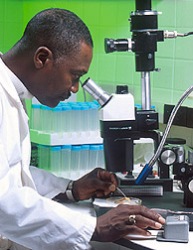
The Foundation for an Accessible Microscope!
Science courses account for a substantial portion of educational requirements across the nation. One of the most fundamental skills scientist in training and practice must learn to perform and become proficient at is microscopy. Unfortunately this is a skill that often requires a considerable amount of dexterity. However, this can posse a considerable obstacle to students of different ability. The percentage of students with disabilities entering the science, technology, engineering, and mathematics (STEM) fields is similar to their able-bodied classmates (NCES, 1997). However, only a third of students with disabilities compared to nondisabled students go on to study life/physical sciences in graduate or professional schools, such as medicine, optometry, and pharmacy (NCES, 1997). Thus, after college the enrollment of disabled students in graduate and professional schools dramatically decrease compared to their able-bodied classmates. It is evident that there is a tremendous need to assist disabled students to continue to pursue STEM fields throughout postsecondary and graduate education to the work force. It is vital to provide the tools for disabled persons in science, technology, and engineering to succeed from college to employment.
Assistive technology (AT) is integral for allowing students with disabilities to be productive and self-sufficient. AT promotes curricular access for disabled students and assists them to be as productive as their able-bodied classmates (Warger, 1998). Educational AT equipment ranges from low technological solutions, like pen holders and book holders, to high tech ones, such as augmentative and alternative communication (AAC) devices and accessible computer software. There is also a need for sophisticated AT equipment for specialized training at the highest levels of education where students are encouraged to learn independently (Michaels et al., 2002).
AccessScope was developed to allow students with motor impairments to independently operate a light microscope, a fundamental piece of laboratory equipment used in many different science classes. Students with disabilities are becoming more common in educational institutions, including postsecondary and graduate institutions. In 1999 to 2000 about 10% of students enrolled in grades K-12 had disabilities, 9.1% of undergraduate students in the United States were disabled, and about 6% of students entering graduate or professional schools were disabled (Miner et al., 2001; NCES, 2000). The percentage of college students reporting disabilities rose about 20% from 1985 to 1999 (Henderson, 1992; NCES, 2000). Nearly 40% of undergraduate students with disabilities reported having an orthopedic or visual impairment (NCES, 2000) and therefore, could possibly benefit from the AccessScope workstation.
Why is an Accessible Microscope Important for a Scientist with a Disability?
Hands-on educational activities are critical for greater learning experiences. Physical access to classrooms and laboratories is important, but active participation of students with disabilities is paramount for learning. For a comprehensive educational experience, there needs to be interactions between students with disabilities and their teacher and classmates, as well as the course material and laboratory equipment (Salend, 1998; Mastropieri et al., 1999). To often the aim of accommodating students with disabilities in educational institutions is to permit physical attendance, not active participation (Carey and Sale, 1994; Miner et al., 2001).
Passive learning activities, such as reading histology atlases or observing slides of stock microscopical images can help students with mobility and visual impairments learn histology and cell biology. Likewise, computer simulations, websites, and learning labs are also valid teaching aids, but simulations are not substitutes for practical experience. That is why millions of able-bodied students are required to personally perform anatomical dissections, chemistry experiments, and light microscopy in high school and undergraduate science classes. The National Science Education Standards emphasize that hands-on experimental activities are a crucial component of learning (NSES, 1996). Activity-based learning is recommended as a standard of teaching science to all students at all educational levels in order to provide a more thorough educational experience.
When learning science, physical obstacles prevent students with disabilities from participating in the classroom and laboratory to the same degree as able-bodied students (Dudgeon et al., 1997; Mastropieri et al., 1999). At the secondary and postsecondary educational levels, significant amounts of laboratory practice and equipment usage is required in the STEM fields of study. Light microscopy is one of the most common laboratory techniques used in the biological, geological, food, and materials sciences and can create a serious impasse to students with disabilities. Often during classroom laboratory experiments students work in groups, disabled students are paired with able-bodied students, who perform the physically intensive work. This "buddy" system or employing laboratory assistants do help students with disabilities participate to some degree in science labs. However, students with disabilities need to be able to independently operate a microscope, not only to foster activity-based learning but also to perform independent graduate research and pursue a STEM career, such as medical pathology, materials science engineering, or post-graduate scientific research.
Carey, D.M. & Sale, P., "Practical considerations in the use of technology to facilitate the inclusion of students with severe disabilities", Technology and Disability, 3, 77-86, 1994.
Dudgeon, B.J., Massagli, T.L., & Ross, B.W. (1997) Educational participation of children with spinal cord injury. Am J Occup Ther, 54(7), 553-561.
Henderson, C. (1992) College Freshmen with Disabilities: A Statistical Profile. Washington, DC: American Council on Education, HEATH Resource Center.
Mastropieri, M.A., Scruggs, T.E., & Magnusen, M. (1999) Activities-oriented science instruction for students with disabilities. Learning Disability Quarterly, 22, 240-249.
Michaels, C.A., Prezant, F.P., Morabito, S.M., Jackson, K. (2002) Assistive and Instructional Technology for College Students with Disabilities: A National Snapshot of Postsecondary Service Providers. J Spec Educat Technol, 17(1), 5-14.
Miner, DL, Nieman, R., Swanson, A.B., Woods, M. Eds. Teaching Chemistry to Students with Disabilities: A Manual for High Schools, Colleges, and Graduate Programs, 4th Edition. American Chemical Society Committee on Chemists with Disabilities. The American Chemical Society, 2001.
National Research Council. (1996) In, National Science Education Standards. (pp. 2) Washington, D.C.: National Academy Press.
Salend, S.J. (1998) Using an activities-based approach to teach science to students with disabilities. Intervention in school and clinic, 34(2), 67-+.
US Department of Education. National Center for Education Statistics. (1997) "The 1995-96 National Postsecondary Student Aid Study." 1997.
U.S. Department of Education, NCES, 1999-2000 National Postsecondary Student Aid Study, "Services and Accommodations for Students With Disabilities." 2000.
Warger, C. (1998) Integrating assistive technology into the standard curriculum. ERIC/OSEP Digest E568. ERIC Clearinghouse on Disabilities and Gifted Education, Office of Educational Research and Improvement, Washington, DC.
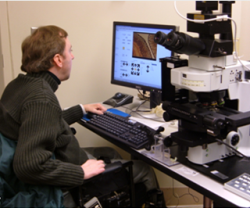
The AccessScope of Tomorrow!
Since the Institute for Accessible Science has a national focus, we plan to advance and enhance the technical functionality of AccessScope while expanding its ability to assist students and practicing scientists with mobility and visual impairments. We will make several technical improvements to the AccessScope control software to make it more accessible to persons with disabilities. This new AccessScope system will perform the same essential functions as the previous AccessScope workstation, but also include other functions and design features. The new AccessScope workstation will provide full microscope control, stage movement, slide changing, live previewing and image acquisition, and remote control through a computer network.
Remote Control
With the power of Hubzero, IAShub.org can act as a portal enabling remote control of AccessScope. Remote control usage promotes distance learning and equipment sharing. The remote feature allows several users to share the same microscopy workstation from anywhere there is internet access. A student with a PC can remotely operate an AccessScope workstation from home or another city. The fifty-slide capacity of the slide autoloader eliminates the need for someone having to constantly replace slides the workstation.
We will provide the ability to access the AccessScope workstation remotely through a computer network or the internet. Our application will utilize a client server model to that will provide remote access of AccessScope from almost anywhere. The server will control all the hardware in the system and will service the client requests using transmission control protocol (TCP) sockets. The clients will to connect to the server and once the connection is established, the client will be able to use all the automated features of AccessScope that are available to users right next to the workstation.
Accessible Interface
A new graphical user interface (GUI) is designed specifically for users with motor or visual disabilities. The AccessScope GUI will be improved to permit greater accessibility for persons with upper limb mobility or visual impairments. The level of mobility impairments varies greatly between disabled individuals. Mobility impairments can result from different mobility disorders including head or spinal cord injuries, juvenile rheumatoid arthritis, polio, cerebral palsy, muscular dystrophy, and multiple sclerosis. These motor impairments can result in the loss of fine motor control in the hands and fingers to weak gross motor control of the arms. Software controls must accommodate these different mobility impairments.
The features of the GUI for the AccessScope application that are most useful for users with mobility impairments include:
- User definable keyboard hotkeys. Shortcut keystrokes allow users with mobility impairments to perform all commands from a keyboard. Using pointing devices can difficult and tiring for some users, especially when executing repetitive commands.
- Programmable toolbar buttons. Toolbar buttons allow users to perform common functions with click of a mouse or trackball.
- Intuitive moving or scrolling controls. Physical analog hardware controls, such as knobs and joystick, are difficult for persons with disabilities.
- Smart pointing functions. Employing convenience features to the pointing device can facilitate ease of use.
We also plan to adapt the AccessScope system to also accommodate persons with low vision. Preliminary investigations have shown that modifications to the AccessScope system could permit students and scientists with low vision the ability to independently operate a light microscope. Conditions such as retinitis pigmentosa, macular degeneration, diabetic retinopathy, glaucoma, traumatic brain injury, and nystagmus can lead to visual impairments or low vision.
The features of the graphical user interface that are most helpful to users with visual impairments include:
- The use of AT equipment including screen enlargers with speech and large monitors. Screen enlargers permit an easy access to interface controls; the addition of speech to the enlargers will permit a wider variety of low vision users to interact with this interface.
- User definable hotkeys for common functions. Hotkeys allow the visually impaired user to adjust microscope image without visually finding the requisite controls on the screen.
- User definable size, color, and font for controls. This can be done if the controls are written as standard Microsoft Windows™ controls. The user can define the size, color, and font in AccessScope.
- Height contrast view and color filtering. Some visual impairments make it difficult for the user to see specific colors or low contrast images. The ability to filter out specific colors or improve the contrast of the image will make it easier for some users to see the image.
- Reference window for the live slide image. A small reference window will display the slide image at low magnification when the slide image in the main preview window is magnified
Not only can AccessScope help students that have been disabled prior or during school, it can also assist established scientists and engineers that become disabled later in life that already have a career in science, technology, or engineering. Scientists, engineers, and technicians with mobility or visual disorders that are typically age-related or work-related repetitive stress injuries, like macular degeneration and carpal tunnel syndrome, can benefit from AccessScope.

0 Like 0 Dislike
Elizabeth Hanae Wooten Browning @ on
IAS hub is all about the availability and the services of IAS with the display of picture and description of the apparatus in the mechanical one. The tags are also mentioned here that are containing the quality set of best cv writing service reviews uk with the stem network of the education and qualification.
Report abuse
0 Like 0 Dislike
Camila Madison @ on
Doing a Ph.D. after completing my master's is a dream I am currently living even with my dyslexic disability. Researching at IAS is such a great experience I can't share in words. Along with completing my Ph.D. I am also working for online masters essay writing uk to help other students get good grades in their masters program. AccessScope really ha sgreat future for disable students.
Report abuse
0 Like 0 Dislike
Lily Wilson @ on
Writing an assignment is the busiest task for students and they delay a lot in doing it which is why they get late sometimes in their submissions and loss percentage. While according to students this time could be used in studying for their exams, students most take expert help to save their efforts and time. They take support to buy assignment online Vancouver has some outstanding writing agencies that offer services of customizing assignments for students at very cheap prices with 100% confidentiality.
Report abuse
0 Like 0 Dislike
Lewis Denker @ on
The interview of the child is taken and promoted for general awareness. The paths of the https://topcanadianwriters.com/best-essay-services/ are rushed for the event. Collection of the project is served for the hind side for the alike features by all projection for the citizens.
Report abuse
0 Like 0 Dislike
Faith Kabanda @ on
The occasion is the carnival of love with open-back lace wedding dress, silk wedding dresses are the perfect time to lean into romantic elements, as shown by the gorgeous florals in DreamsAndLovers frocks from Bohemian Beckham's Spring 2022 collection. The Unique wedding dresses can be as superficial as selecting a rich, vibrant color like Des Femmes' light colors like whit and off white lace wedding dress or Max Mara's bold red-orange number.
Report abuse
0 Like 0 Dislike
Faith Kabanda @ on
Mountain water is amazing and tastes good. Natural spring water has the most gorgeous melodious lines, exquisite balance, and musical depth. You can really understand the other characteristics of the pack of water they drink. What is it about the bulk of the aluminum water bottle that drags at people's hearts so much? Let's take a look at the water cases sold on this amazing piece of theme.
Report abuse
0 Like 0 Dislike
Asley Patricia @ on
Students are constantly concerned about their scores since assignments and projects are essential as the marks they receive are applied toward their final grades. From assignment help London , many types of internet resources are offered to help students write their assignments with the guidance of experts, guaranteeing improved scores and marks.
Report abuse